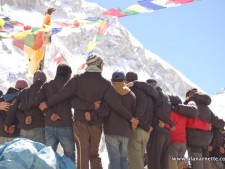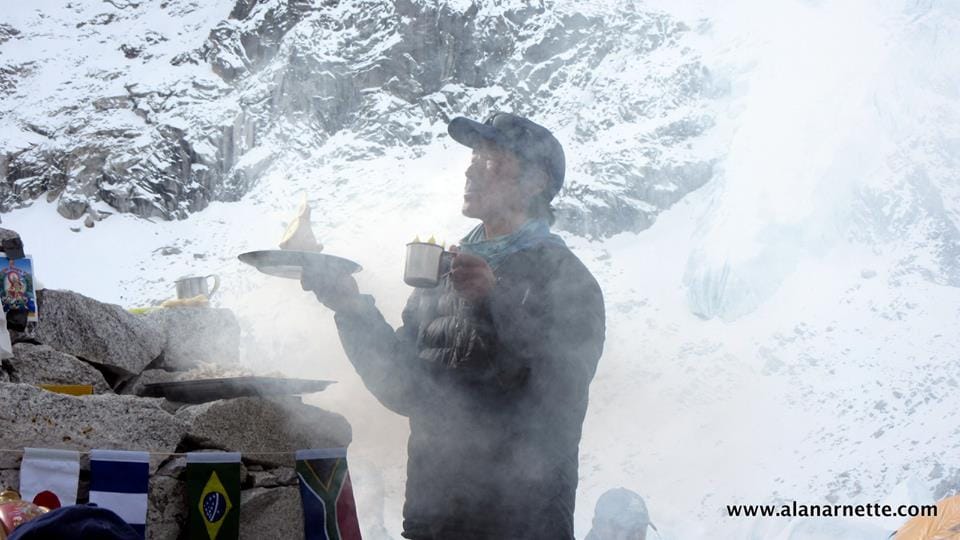The base camps are coming together on both sides as the teams continue to arrive. Climbers are doing some skills review while the Sherpas build the high camps. A few teams have already entered the Khumbu Icefall. It looks like members will begin to climb to Camp 1 in a couple of days. So far, so good.
Chinese Base Camp (CBC)
On the Tibet side, base camp is usually called the Chinese Base Camp aka CBC. It is tightly run by a member of the Chinese Mountaineering Association, or the Chinese Tibet Mountaineering Association, CMA/CTMA respectively. There is a person who serves as judge and jury on all matters living at CBC.
Kari Kobler sent me a message today describing progress on the North side:
Who is the base camp? These are the four organizations for many years prefer the north side of Mt. Everest. That means: Himalaya Expedition, the local agency in Lhasa. Then Seven Summits from Russia. The great Indian Agency, headed by Arun Trek. Alpenglow, with the head of Adrian Bellinger from America, he has been working this year closely with Kobler & Partner together. Then one of the oldest agencies on the north side of Mt. Everest: Kobler & Partner, led by Andreas Neuschmid and Kari Kobler. Dawa from Arun Trek and Kari Kobler are the first expedition leader on site and inspect the construction of the base camp, and the intermediate camp and ABC. In a few days we will reach the Northcol and set up.
Also Summit Climb, Seven Summits Treks and Furtenbach Adventures have arrived with a few more in route. See their locations here. Lots of good progress on that side. On the North this year is the youngest Australian to summit Mt Everest at age 19 in 2016 from the Nepal side, Alyssa Azar going for the summit from the North.
Everest Base Camp (EBC)
On the Nepal side, base camp is usually called Everest Base Camp aka EBC. It is loosely run by a representative of the Nepal Ministry, Gyanendra Shrestha, and each team has a liaison officer, who rarely shows up but that is supposed to change this year.
The first members went into the Icefall from multiple teams today. Jagged Globe gave this update:
Everest Base Camp was shrouded in low cloud and mist at 03.00 when the team set off for their second practice climb in the Khumbu Icefall. A few hours later they had climbed into clearer weather as dawn broke over the mountains. The target height of 5,850m was reached by 07.00 and the team were back in Base Camp enjoying breakfast by 09.30.
Climbing conditions in the lower section of the icefall are excellent at the present time. Much of the surface underfoot is snow rather than hard ice. The route avoids most of the larger crevasses and this reduces the numbers of ladders needed to a minimum. The team are hoping that similar conditions exist for the final section up to Camp 1 and they are hoping to complete this section of the climb on the morning of 18 April.
Staying Connected
Daniel Wallace gave us an update on WiFi at EBC. She says it’s up and pretty fast unlike NCELL, the cell phone service that has 3/4G but with spotty service at EBC. As always, sat phones are most reliable, but expensive. Thuraya is the service of choice for most Everest climbers. EverestLink provides the WiFi service and has a number of antennas all around camp to service the 1,000 some odd devices. It is then connected through a series of microwave links to a backbone carrier, which used to be located in India, not sure today. Daniel added “Our camp has its own WiFi mast but sadly went down last night. Have to walk over to the next door camp to get signal. Hopefully this and other tweaks will sort themselves out before we get back from Loboche East. There is an option to buy a months wifi for $220. If I can I will and will then be able to bore you with photos. ????”
Mingma G Sherpa shared this picture of his team heads down on their phones! The Chinese double-amputee climber Xia Bo-Yu is on their team.

Puja
Before any climber, or Sherpa, begins climbing, they must have a Puja. This is mandatory for the Sherpa and something they take extremely seriously. While westerners are invited to participate, and almost everyone does, if they choose not to, it’s not a big deal. But it is a special part of any Himalayan climb and, for me, something never to be missed.
The puja is a traditional ceremony lead by a Lama where the mountain Gods are asked permission for the climbers to climb and forgiveness for the damage caused by the climbing and for the safety of everyone involved. All the Sherpas, climbers, cooks – anyone associated with the climb participates. Many teams arrange multiple blessings: one in Kathmandu, and other during the trek in and the most important one at Base Camp which is also called a Puja. The ceremony is always somewhat similar starting with the building of a large rock chorten that holds pictures of the Dali Lama and small models of the mountains made in barley paste.
-
Inside a Puja
This was from my 2011 Everest summit climb:

They all chanted in unison reading century old prayers from Tibetan prayer books. Climbers sat in rows behind the Lama and Sherpas and everyone else mingled around. Serious but not terminally so, camera shutters and video cams were in full action trying to capture the moment.
Sherpas poured milk tea, a sweet concoction of sugar, milk, and tea. The Lama and his Sherpas drank milk tea and chang, a potent rice wine. Food had been prepared the night before consisting of breads and other sweets.
After an hour, the prayers were complete and the puja pole was raised on top of the Alter. This held flags and served as the central point for strings of long prayer flags that covered our camp. The Sherpas moved with precision to erect the pole and raise the flags.
Now the energy really increased with more tea being poured. All stood up as another series of chants took place ending with everyone throwing rice into the air three times and cheering. This was for good luck, an offering of sorts. This was followed by the tradition of spreading barley power on one another’s face. This was also for luck with the white powder on our faces symbolizing awhile beard of old age, not sure how our female climbers took this! I took pride in spreading it on Kami and he on mine. It was really quite the mess!
As the Sherpas started to sing and line dance, I stepped off to the side. The icefall looked grand in full sun with no shadows. The 5 color prayer flags were held straight against their line by just a wisp of a wind. Everyone was smiling, laughing and simply having a good time.
But it occurred to me watching how the climbers interacted compared with the Sherpas, that this puja was more about the Sherpas. They shared food, embraced one another in the line dance with ease, smiled so easily and laughed sincerely. Yet, there was a seriousness and a conviction to their efforts that left the ceremony behind.
These Sherpas were affirming their dedication to one another on yet another dangerous climb of the highest mountain on earth. Sherpas die each year on Everest. They know this all too well. This ceremony was certainly to honor and make request of the mountain Gods but it was also commit themselves to one another, to be there when needed, to support and be supported when the time came.
This spurred me to consider the Alzheimer’s community; the individuals, the family caregivers, the caregivers in facilities, the researchers, the academic and business element. Are we as committed to one another as these Sherpas? The stakes are higher. Are we willing to work together in search of improved ments, caregiver support and finding a cure?
These Sherpas know sacrifice like few in the climbing community. Away from families for months on end risking their lives all for a better future for their families.
Caregivers make sacrifices as well sometimes leaving jobs, making extreme financial sacrifices for only one purpose. Researchers spend their professional lives running theories as far as they can, or until they run out of money.

As I climb Everest and the other 7 Summits, perhaps we can use this as an opportunity to bring the Alzheimer’s community together for the single goal of eliminating this disease.
Volunteer at a local nursing home or Alzheimer’s care facility to hold someone’s hand, listen to them talk about their memories before they are gone. Learn about Alzheimer’s. Talk to your aging parents about the disease. Make plans, be prepared if this sad reality impacts your family or a friend’s.
There is so much to do. And there is no reason to wait.
As I watched the Sherpas return to their tents and duties, they moved with unity and purpose.
Can we do the same?
Climb On!
Alan
Memories are Everything



